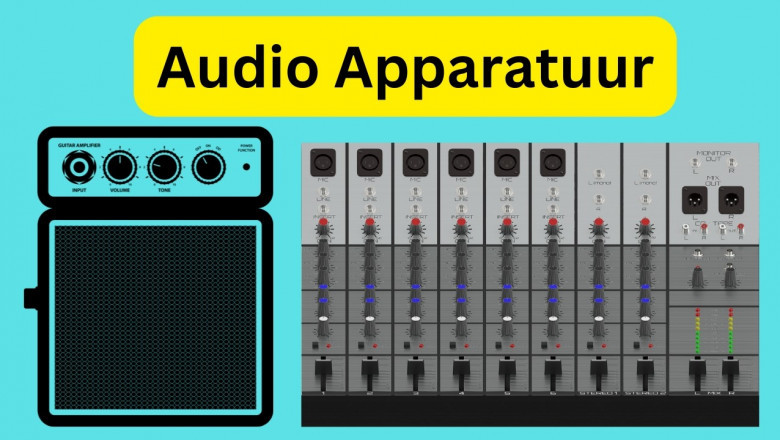views
Sound has the power to transform moods, evoke memories, and create immersive experiences. Whether it's the crisp notes of a symphony, the deep bass of a hip-hop track, or the clear dialogue in a film, having a refined taste for audio enhances the way we experience the world. In this article, we explore what it means to develop a taste for audio, the science behind sound quality, and how to curate the perfect listening experience.
What Does “Taste for Audio” Mean?
Having a "taste for audio" is akin to having a palate for fine wine or gourmet food. It reflects an appreciation for the nuances and quality of sound. This taste can be applied to various domains, such as music, movies, podcasts, and even the sound design of everyday products like smartphones or home assistants.
Key Elements of Audio Taste
-
Clarity: The ability to distinguish individual elements, such as instruments or voices.
-
Balance: A well-mixed sound where highs, mids, and lows complement each other.
-
Depth: The spatial quality of sound that makes it feel immersive.
-
Authenticity: A natural sound that replicates the real-world experience.
The Science Behind Exceptional Audio
To understand why certain sounds resonate more, it's important to delve into the science of acoustics and audio engineering.
1. Frequency Range
Human hearing typically spans from 20 Hz to 20,000 Hz. High-quality audio captures this full spectrum, ensuring no part of the sound is lost.
-
Bass (20–250 Hz): Responsible for the depth and richness of sound.
-
Midrange (250–4,000 Hz): Where most vocals and instruments lie.
-
Treble (4,000–20,000 Hz): Adds sparkle and detail to audio.
2. Dynamic Range
Dynamic range refers to the difference between the quietest and loudest parts of a track. A wide dynamic range ensures that subtle nuances and powerful crescendos are equally audible.
3. Harmonic Distortion
Lower distortion levels result in cleaner sound. High-end audio equipment minimizes harmonic distortion, maintaining the integrity of the original recording.
How to Develop a Taste for Audio
Developing a sophisticated audio palate requires both education and exposure. Here’s how to refine your taste:
1. Listen Critically
Pay attention to details such as the placement of instruments, the clarity of vocals, and the balance of the mix. Use high-quality headphones or speakers for this purpose.
2. Explore Different Genres
Each genre has unique audio characteristics. Classical music offers depth and complexity, while electronic music emphasizes bass and treble. Exploring various styles helps broaden your appreciation.
3. Invest in Quality Equipment
High-quality equipment such as noise-canceling headphones, studio monitors, or high-fidelity (Hi-Fi) systems can dramatically enhance your listening experience.
4. Attend Live Performances
Live music allows you to experience sound in its rawest form. Use these events to compare live acoustics with recorded versions.
5. Educate Yourself
Read about audio engineering, mixing techniques, and sound design to better understand the art behind great audio.
The Role of Technology in Shaping Audio Preferences
Modern technology has significantly influenced how we consume and evaluate audio.
1. Streaming Services
Platforms like Spotify, Apple Music, and Tidal offer high-resolution streaming options, making high-quality audio accessible to the masses.
2. Smart Audio Devices
Products like smart speakers and wireless earbuds often include features like adaptive EQ and spatial audio, elevating the listening experience.
3. Noise-Canceling Technology
By eliminating background noise, noise-canceling headphones help listeners focus solely on the audio.
4. Artificial Intelligence
AI-powered tools analyze listening habits to provide personalized recommendations, helping users discover new sounds that align with their tastes.
Creating the Perfect Listening Environment
Your environment plays a crucial role in how you perceive sound. Here are tips to optimize your audio experience:
1. Minimize Background Noise
Choose a quiet space or use noise-canceling equipment to eliminate distractions.
2. Invest in Acoustic Treatments
Soundproofing walls, adding rugs, and using acoustic panels can improve sound clarity by reducing echoes.
3. Position Your Speakers Correctly
For optimal sound, speakers should be placed at ear level and angled towards the listener.
4. Use High-Quality Audio Files
Compressed audio files lose detail. Opt for lossless formats like FLAC or WAV for the best sound quality.
The Emotional Impact of Great Audio
Exceptional audio does more than please the ears—it evokes emotions and memories. Here's how:
-
Music Therapy: Well-mixed tracks can uplift moods or calm anxieties.
-
Immersive Films: Clear dialogue and powerful soundtracks enhance storytelling.
-
Gaming: Spatial audio makes virtual environments feel real, heightening immersion.
Future Trends in Audio
The audio industry is constantly evolving, with exciting innovations on the horizon:
-
3D Audio: Technologies like Dolby Atmos create multi-dimensional soundscapes for a fully immersive experience.
-
Biometric Listening: Devices that adjust audio based on individual hearing profiles.
-
Sustainable Audio Equipment: A focus on eco-friendly materials and energy-efficient designs.
Conclusion
Developing a taste for audio is an enriching journey that enhances your appreciation for sound in all its forms. By understanding the science behind audio, investing in quality equipment, and cultivating a critical ear, you can transform everyday listening into a deeply satisfying experience.
So, whether you're tuning into your favorite playlist, watching a blockbuster movie, or attending a live concert, take the time to savor the details. After all, great audio isn’t just heard—it’s felt.






















Comments
0 comment